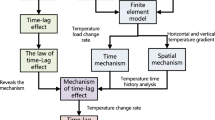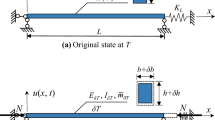Abstract
The time-lag effect between temperature and thermal displacement may induce the displacement-based safety assessment results of long-span bridges to derivate from the truth. In this paper, the typical characteristics of the time-lag effect between temperature and thermal displacement are firstly investigated by using the synchronously monitored temperature and displacement data from a long-span steel box-girder arch bridge. And then, the inherent reasons of the time-lag effect are found out by employing the Kendall correlation coefficient. Following that, a general method derived from the Bayesian function registration model and the Z-mixture preconditioned Crank-Nicolson algorithm is proposed to compensate the time-lag effect. Finally, the proposed compensation method is verified by data from three bridges and compared with the traditional method achieved through shifting a fixed time interval. The results show that thermal displacement may be ahead of or lag behind temperature, depending on the temperature and thermal displacement of concern. The lag time varies from a few minutes to several hours with temperature and displacement variables, as well as time instants. The time-lag effect between temperature and thermal displacement is caused by the asynchronous change of the dominant temperature for the specific thermal displacement and other temperatures because of different material thermodynamic parameters and geometric characteristics of different bridge components. The developed compensation method can completely eliminate the time-lag effect between temperature and thermal displacement of various long-span bridges without any pre-correlation analysis and prior knowledge. The correlation between temperature and thermal displacement compensated by the method proposed in this paper is much stronger than that compensated by the traditional method.


















Similar content being viewed by others
Data availability
The data that support the findings of this study are available on request from the corresponding author. The data are not publicly available due to privacy or ethical restrictions.
References
Svendsen BT, Frøseth GT, Øiseth O, Rønnquist A (2021) A data-based structural health monitoring approach for damage detection in steel bridges using experimental data. J Civ Struct Heal Monit 12:101–115. https://doi.org/10.1007/s13349-021-00530-8
Mishra M, Barman SK, Maity D, Maiti DK (2019) Ant lion optimisation algorithm for structural damage detection using vibration data. J Civ Struct Heal Monit 9:117–136. https://doi.org/10.1007/s13349-018-0318-z
Ye S, Lai X, Bartoli I, Aktan AE (2020) Technology for condition and performance evaluation of highway bridges. J Civ Struct Heal Monit 10:573–594. https://doi.org/10.1007/s13349-020-00403-6
Shan J, Wang L, Loong CN, Zhou Z (2023) Rapid seismic performance evaluation of existing frame structures using equivalent SDOF modeling and prior dynamic testing. J Civ Struct Heal Monit 13:749–766. https://doi.org/10.1007/s13349-023-00677-6
Yarnold MT, Moon FL, Aktan AE (2015) Temperature-based structural identification of long-span bridges. J Struct Eng 141(11):04015027. https://doi.org/10.1061/(ASCE)ST.1943-541X.0001270
Liu Y, Deng Y, Cai C (2015) Deflection monitoring and assessment for a suspension bridge using a connected pipe system: a case study in China. Struct Control Health Monit 22:1408–1425. https://doi.org/10.1002/stc.1751
Han Q, Ma Q, Xu J, Liu M (2021) Structural health monitoring research under varying temperature condition: a review. J Civ Struct Health Monit 11(1):149–173. https://doi.org/10.1007/s13349-020-00444-x
Xu Y, Chen B, Ng CL, Wong K, Chan W (2010) Monitoring temperature effect on a long suspension bridge. Struct Control Health Monit 17:632–653. https://doi.org/10.1002/stc.340
Zhou Y, Xia Y, Fujino Y, Yamaguchi K (2021) Analytical formulas of thermal deformation of suspension bridges. Eng Struct 238:112228. https://doi.org/10.1016/j.engstruct.2021.112228
Li LF, Chen B, Zhou LR, Xia Q, Zhou Y, Zhou XQ, Xia Y (2023) Thermal behaviors of bridges—a literature review. Adv Civil Eng 26(6):985–1010. https://doi.org/10.1177/13694332231153976
Potgieter IC, Gamble WL (1989) Nonlinear temperature distributions in bridges at different locations in the United States. PCI J 34(4):80–103
Ni YQ, Hua XG, Fan KQ, Ko JM (2005) Correlating modal properties with temperature using long-term monitoring data and support vector machine technique. Eng Struct 27:1762–1773. https://doi.org/10.1016/j.engstruct.2005.02.020
Ni YQ, Hua XG, Wong K, Ko JM (2007) Assessment of bridge expansion joints using long-term displacement and temperature measurement. J Perform Constr Facil 21:143–151. https://doi.org/10.1061/(ASCE)0887-3828(2007)21:2(143)
Catbasa FN, Susoyb M, Frangopol DM (2008) Structural health monitoring and reliability estimation: long span truss bridge application with environmental monitoring data. Eng Struct 30:2347–2359. https://doi.org/10.1016/j.engstruct.2008.01.013
Kromanis R, Kripakaran P (2014) Predicting thermal response of bridges using regression models derived from measurement histories. Comput Struct 136:64–77. https://doi.org/10.1016/j.compstruc.2014.01.026
Yang D, Yi T, Li H, Zhang Y (2018) Monitoring and analysis of thermal effect on tower displacement in cable-stayed bridge. Measurement 115:249–257. https://doi.org/10.1016/j.measurement.2017.10.036
Zhou, G, Yi T, Chen B, Chen X (2018) Modeling Deformation induced by thermal loading using long-term bridge monitoring data. J Perform Constr Facil 32(3): 04018011. https://doi.org/10.1061/(ASCE)CF.1943-5509.0001154.
Battista N, Brownjohn J, Tan H, Koo KY (2015) Measuring and modelling the thermal performance of the Tamar Suspension Bridge using a wireless sensor network. Struct Infrastruct Eng 11(2):176–193. https://doi.org/10.1080/15732479.2013.862727
Hu J, Wang L, Song X (2020) Field monitoring and response characteristics of longitudinal movements of expansion joints in long-span suspension bridges. Measurement 162:107933. https://doi.org/10.1016/j.measurement.2020.107933
Westgate R, Koo KY, Brownjohn J (2015) Effect of solar radiation on suspension bridge performance. J Bridge Eng 20(5):04014077. https://doi.org/10.1061/(ASCE)BE.1943-5592.0000668
Wang ZW, Zhang WM, Zhang YF, Liu Z (2022) Temperature prediction of flat steel box girders of long-span bridges utilizing in situ environmental parameters and machine learning. J Bridge Eng 27:04022004. https://doi.org/10.1061/(ASCE)BE.1943-5592.0001840
Ju H, Zhai W, Deng Y, Chen M, Li A (2023) Temperature time-lag effect elimination method of structural deformation monitoring data for cable-stayed bridges. Case Stud Thermal Eng 42:102696. https://doi.org/10.1016/j.csite.2023.102696
Guo T, Liu J, Zhang Y, Pan S (2015) Displacement monitoring and analysis of expansion joints of long-span steel bridges with viscous dampers. J Bridge Eng 20(9):04014099. https://doi.org/10.1061/(ASCE)BE.1943-5592.0000701
Yang D, Yi T, Li H, Zhang Y (2018) Correlation-based estimation method for cable-stayed bridge girder deflection variability under thermal action. J Perform Constr Facil 32(5):04018070. https://doi.org/10.1061/(ASCE)CF.1943-5509.0001212
Zhou, G, Yi T, Chen B (2017) Innovative Design of a Health Monitoring System and Its Implementation in a Complicated Long-Span Arch Bridge. J Aeros. Eng B4016006. https://doi.org/10.1061/(ASCE)AS.1943-5525.0000603.
Roeder CW (2002) Thermal movement design procedure for steel and concrete bridges. University of Washington, Seattle, WA, USA
Aashto (2017) LRFD-8 AASHTO LRFD bridge design specifications. Washington DC, USA: AASHTO.
Li N, Zhang X, Zhou X, Leng J, Liang Z, Zheng C, Sun X (2008) Introduction of structural health and safety monitoring warning systems for Shenzhen-Hongkong western corridor Shenzhen bay bridge. Health Monitoring Struct Biol Syst 6935:69351L-L69361. https://doi.org/10.1117/12.775827
Tucker JD, Wu W, Srivastava A (2013) Generative models for functional data using phase and amplitude separation. J Comput Stat Data Anal 61:50–66. https://doi.org/10.1016/j.csda.2012.12.001
Lu Y, Herbei R, Kurtek S (2017) Bayesian registration of functions with a gaussian process Prior. J Comput Graph Statist 26(4):894–904. https://doi.org/10.1080/10618600.2017.1336444
Tucker JD, Wu W, Srivastava A (2014) Analysis of proteomics data: phase-amplitude separation using an extended Fisher -Rao metric. Electron J Statist 8(2):1724–1733. https://doi.org/10.1214/14-EJS900B
Srivastava, A, Wu W, Kurtek S, Klassen E, Marron J S (2011) Registration of functional data using fisher-rao metric. arXiv preprint, arXiv 1103.3817.
Srivastava, A, Jermyn I, Joshi S (2007) Riemannian analysis of probability density functions with applications in vision. IEEE CVPR. 1–8. https://doi.org/10.1109/CVPR.2007.383188.
Cotter SL, Roberts GO, Stuart AM, White D (2013) MCMC methods for functions: modifying old algorithms to make them faster. Statist Sci 28:424–446. https://doi.org/10.1214/13-STS421
Acknowledgements
This research work was supported by the National Natural Science Foundation of China (Grant Nos. 51978243). The authors would like to express their appreciation to Prof. Chunfeng Wan and Dr. Huachen Jiang from Southeast University for their valuable suggestions.
Author information
Authors and Affiliations
Corresponding author
Ethics declarations
Conflict of interest
The author(s) declared no potential conflicts of interest with respect to the research, authorship, and/or publication of this article.
Additional information
Publisher's Note
Springer Nature remains neutral with regard to jurisdictional claims in published maps and institutional affiliations.
Appendices
Appendix A
The SRSF of the warping function \(\gamma (t)\) is
Since \(\gamma \left(0\right)=0\), this mapping operation is invertible. One typical feature of \(\psi \left(t\right)\) is that it has unit \({{\text{L}}}_{2}\) norm as follows
The resulting space \({\mathbb{Q}}\) (\(\psi \left(t\right)\in {\mathbb{Q}}\)) is the positive orthant of the unit sphere in the Hilbert space \({{\text{L}}}_{2}\). On the space, the distance can be defined by the arc-length, and the mapping operation also has the property of isometry. Although the SRSF transformation simplifies the complicated geometry of \(\Gamma\), the space \({\mathbb{Q}}\) is yet to be linear and cannot meet the requirement of the Bayesian function registration. As a result, the further transformation is required.
The space \({\mathbb{Q}}\) is mapped onto a tangent space. The identity element \({\gamma }_{{\text{id}}}\left(t\right)\in\Gamma\) accordingly maps to a constant function \(1\in {\mathbb{Q}}\). The tangent space at this specified point is
where \(g\) is the representation of the warping function \(\gamma (t)\) in the tangent space. One way to connect \({\mathbb{Q}}\) and \({\rm T}_{1}\left({\mathbb{Q}}\right)\) is via the exponential map and inverse exponential map, which are defined as
where \(\theta\) is the vectorial angle between 1 and \(\psi\).
Appendix B
In Eq. (15), the prior and posterior distributions of \(\left(g,{\sigma }_{1}^{2}\right)\) are probability measures defined on the product space \({\rm T}_{1}\left({\mathbb{Q}}\right)\times {\mathbb{Q}}\). Specifically, the prior measure is the product measure \({\mu }_{0}\equiv \text{Gaussian }\left(0,{\mathcal{C}}_{g};\,{I}_{A}\right)\times IG(a, \, b)\) and the posterior measure \(\mu\) is absolutely continuous with respect to the prior measure. By using Bayesian formula, the Radon-Nikodym derivative of the posterior measure \(\mu\) is
where \(L\left(\bullet ,\bullet \mid {f}_{1},{f}_{2}\right)\) is the likelihood function given by
The Metropolis in Gibbs algorithm could be adopted to search the posterior distribution given by Eq. (B.1). At each iteration, the component \({\sigma }_{1}^{2}\) is updated with values extracted from the conditional distribution as follows:
While the functional component \(g\) is updated by the Metropolis–Hastings step. In this step, the functional component \(g\) could be obtained by the Z-mixture pCN algorithm, which is
where \({g}^{\prime}\) is the updated functional component \(g\).
Rights and permissions
Springer Nature or its licensor (e.g. a society or other partner) holds exclusive rights to this article under a publishing agreement with the author(s) or other rightsholder(s); author self-archiving of the accepted manuscript version of this article is solely governed by the terms of such publishing agreement and applicable law.
About this article
Cite this article
Zhou, HL., Zhou, GD., Qiao, ZQ. et al. Time-lag effect of thermal displacement and its compensation method for long-span bridges. J Civil Struct Health Monit 14, 1017–1033 (2024). https://doi.org/10.1007/s13349-024-00769-x
Received:
Accepted:
Published:
Issue Date:
DOI: https://doi.org/10.1007/s13349-024-00769-x




